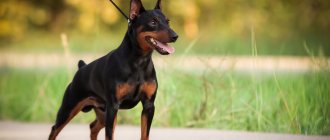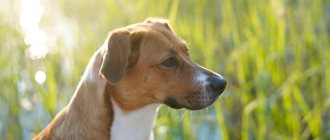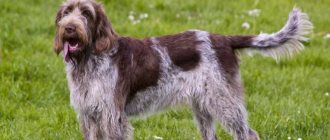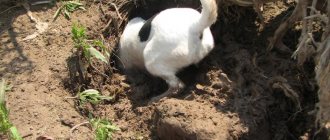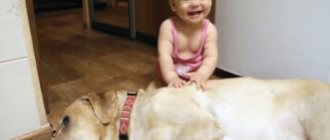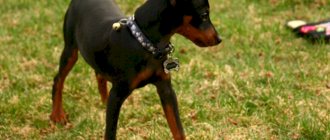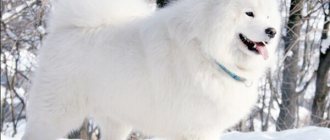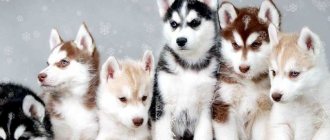The Miniature Pinscher is a small, cheerful dog that can become a devoted companion, accompanying its owner everywhere. Despite its small size, it is a strongly built, active dog, fearlessly rushing to defense and possessing protective qualities. The Miniature Pinscher is a very popular breed because it does not require serious care and is easy to train. But before you get such a pet, you need to study its description, character traits, reviews from owners, and the pros and cons of keeping it.
- Standard
- Miniature Pinschers Training
- Hygiene
History of the origin of the breed
The homeland of the miniature pinscher breed is Germany, where the first miniature smooth-haired pinschers or so-called miniature Dobermans appeared almost three centuries ago.
This is interesting! There are no reliable sources indicating the origin of the miniature pinscher, but the very first mentions of dogs similar in appearance to the miniature pinscher date back to the mid-fifteenth century.
According to some versions, the ancestors of the breed were Scandinavian dogs that lived on the Baltic shores and near Swiss lakes. Most likely, the black and tan English terrier was brought to Germany from Great Britain.
It was on the basis of this dog that it was possible to develop a smaller variety of the breed, rich in different colors, including brown, chocolate, light red, blue, as well as shiny black with very pronounced tan marks. Dogs with a very original deer color in Germany were called “Re-pinscher”.
Miniature Pinschers are an old breed, and some external resemblance to Doberman Pinschers was acquired post facto . Initially, pinschers were housed near stables, where small dogs were used not only as guards, but also for catching various rodents.
However, over time, this breed gained increased attention and gradually turned into a very popular house pet. Starting from the second half of the nineteenth century, German breeders began targeted breeding work with the aim of breed improvement of the miniature pinscher.
Application of "Mini Doberman"
The pocket pinscher, although miniature in size, is not suitable for the role of a decorative dog that will accompany at events, sitting calmly in the owner’s arms.
Mini Doberman
The scope is quite wide. They have developed guard qualities, courage and intelligence, which allows them to perform official duties. In addition, although they are not a hunting breed, they are highly trainable. Thanks to this, they can be taken on small game hunts.
In a private home, they can take on hunting responsibilities independently. Miniature pinschers will not only catch mice, but also rats even larger than themselves . The dog can also serve as an alarm system due to its protective qualities, notifying its owners with loud barks about strangers entering the owner’s territory.
Description of the Miniature Pinscher breed
The miniature pinscher is a harmoniously built animal; in its exterior it does not have the signs characteristic of dwarfism:
- There are very strict growth (at the withers 25-30 cm) of the animal. The weight of an adult dog is 4-6 kg.
- The body is compact, muscular, dry, with a deep square chest, somewhat sloping back and prominent withers.
- The front legs are of medium length, muscular, straight, set at a distance. The elbows are in the correct position, not turned out or tucked in. The structure of the paw is somewhat reminiscent of a cat's, with tightly closed, arched toes and medium-length black claws.
- The eyes are always dark in color, somewhat almond-shaped, without signs of bulging. They are located far apart on the muzzle, the eyelids close tightly and have dark pigmentation along the edges.
- The head is clearly defined, triangular in shape. Nose with a black mirror, straight back. The shape of the skull is oblong, smoothly turning into a gracefully curved neck. The forehead is smooth and has a not sharp, but pronounced transition to the base of the nose.
- The jaws close in a scissor bite, strong, with a full set of (42) teeth. Despite the fact that the chewing muscles are well developed, they do not violate the contours and do not protrude on the cheekbones. The lips are pigmented black, closed throughout.
- The ears are set high, erect or slightly drooping, triangular, giving the small dog a warlike appearance. Sometimes the ears are cropped, but this is not mandatory.
- The neck is quite long, has a smooth, noble bend without a pronounced transition to the withers. The skin fits tightly, there are no folds and dewlap or dewlap.
- The torso is strong, muscular, and compact due to the fact that the distance from the lower edge of the costal arch to the thigh is small. The lower abdomen forms a soft roundness that extends into the groin. The tail is docked in some countries, but most often it is natural.
Intrabreed types from different countries have some differences. American dogs have a compact, lean body with harmoniously defined muscles. They amaze with their grace and sophistication. Mini-pinschers from Israeli breeders are surprisingly similar in appearance to Doberman Pinschers and have a beautiful sweeping trot.
Powerful, muscular with a stocky torso, German mini-pinschers and calm Scandinavians, beautiful in their naturalness, also have their fans.
How long do miniature pinschers live?
With a balanced diet and proper care, the life expectancy of miniature pinschers is 14-15 years.
The diet of a miniature pinscher can consist of high-quality dry or natural food. It is important that the animal’s body is saturated with minerals, vitamins, micro- and macroelements necessary for normal, full-fledged life.
The menu should consist of red, chicken or turkey meat, offal (liver, heart, lungs), buckwheat, rice porridge. Mini pinschers benefit from eating goat's milk, low-fat cottage cheese, milk, and vegetables (carrots, cauliflower, broccoli, pumpkin).
Your Miniature Pinscher baby should be provided with fresh and cool drinking water.
It is prohibited to contain white cabbage, river fish, semolina, bread, sweets, smoked meats, citrus fruits, and cow's milk in the diet of miniature pinschers.
Advantages and disadvantages
The Miniature Pinscher is a miniature but agile breed that is not suitable for couch potatoes or people in poor health. These dogs require active play and physical exercise, but they are unpretentious in food and living conditions, almost do not shed, and can be kept even in a small apartment. The main advantages and disadvantages of the breed are analyzed in detail in the table.
Table - Pros and cons of the miniature pinscher dog breed
| pros | Minuses |
| - Can be kept in a regular apartment; - endurance and good health; - developed protective instinct; - unproblematic wool; - rare shedding; - unpretentiousness in food; - learning ability | - They get cold in winter, they need clothes; - small for a watchman, but too active for decoration; - need regular physical activity; - require serious education; - may show willfulness or try to dominate the owner |
Care
One of the simplest of all companion dogs. They do not need professional grooming, just regular brushing. For most people, simply wiping with a towel will suffice. Yes, they shed, but not excessively, since the coat is short and there is no undercoat. One of the features of the breed is poor tolerance to low temperatures . They have neither long enough hair, nor undercoat, nor fat for this. In cold and damp weather, you need to wear special clothing, and in cold weather, limit your walks.
Character
The Miniature Pinscher is very cheerful and energetic, has high intelligence, attentiveness and passion. On the one hand, these dogs are affectionate and faithful, on the other – stubborn and wayward.
- Miniature Pinschers get along well with children and all family members.
- Despite their selfless love for their owner, these animals do not tolerate excessive displays of feelings and are not delighted with constant “tenderness” and stroking. Therefore, they can behave a little aggressively at such moments.
- Very distrustful of strangers.
- Miniature pinschers are friendly towards other pets, provided they have known them since childhood. If you are planning to have a new pet after the arrival of a miniature pinscher in the family, you should devote some time to adaptation and establishing contact between the animals.
- These dogs are very curious and enjoy getting to know everything new that surrounds them.
- During walks, it is better to keep your pet on a leash, because despite their miniature stature, miniature pinschers are very cocky towards other dogs, even if they are larger than them.
The peculiarity of the breed of these, at first glance, cute dogs is their very loud barking. They greet all the guests and animals who visit the master's house with it.
Owner reviews
Among all the reviews from dog breeders about various breeds of pinschers, one can highlight opinions about specific pets:
DarkAngel/2297 (Russia, Samara)
The Miniature Pinscher has been living in the house for several years now. It should be noted that this is a very affectionate and loyal friend who loves to be the center of attention. However, he is extremely active and problems arise during the training process.
Kaplya (Russia, Krasnodar)
A Doberman Pinscher lives in the house. We love this pet very much, but we can immediately say that dogs of this breed are not for every dog owner. Despite their positive qualities - short-haired, intelligent, graceful creatures quickly get used to their owner, they also have serious disadvantages. They can be vicious and love to dominate, so raising Dobermans can be quite difficult. But if you find an approach to the dog, it will become your best and most devoted friend.
In general, you can buy any variety of pinscher and never regret your choice - after all, these pets are so loyal and loving, and their maintenance and training will not be a burden even for novice dog breeders. And if the apartment is not too large, then you can buy a dwarf Pinscher or Affenpinscher, which do not take up much space, but will be the best and most loyal friends despite their small size.
Training
Training a miniature pinscher is mainly aimed at controlling leadership aspirations. It is recommended to start training at 3-4 months, when the puppy’s nervous system has already formed and he is ready to understand the requirements and follow commands.
The training is based on the dogs' natural inclinations. Training should develop useful skills in the dog and minimize individual character flaws. The desire to assert leadership and aggressiveness with age can turn a dog into an evil creature that brings nothing but trouble.
Firmness in training is required, but the miniature pinscher should be treated with patience, introducing punishment only in extreme cases. The trainer must remember the proud, touchy nature of the dog. Rudeness and pity are equally unacceptable in raising a dog. He is very smart, and indulging his whims will quickly develop into manipulation.
But in general, the miniature pinscher responds well to training, and with the right approach, an active, playful puppy will grow into an intelligent, loyal, balanced companion.
Interesting Facts
Miniature pinschers are among the smallest representatives of pinschers. However, they are distinguished by stubbornness and willfulness, which are not characteristic of even a large and strong Doberman.
Miniature pinschers are excellent manipulators. The owner often does not realize this quality of his four-legged friend.
Miniature pinschers are the best friends for energetic schoolchildren and teenagers. It is impossible for children and the elderly to keep up with an active pet, much less walk and raise a smart but wayward dog.
Due to their excessive activity, miniature pinschers are considered by many to be hysterical animals. However, their nervous system is in perfect order. They are balanced, but very playful and restless. It's just a character trait.
The miniature pinscher strives to be a leader among other pets and to be on an equal footing with its owner.
The educational process of a miniature pinscher should never stop. Otherwise, the mini Doberman will relax and stop listening to the owner.
Varieties
The Miniature Pinscher dog breed itself is not divided into varieties. In fact, she herself is a subspecies in the extensive pinscher family. The closest relatives of miniature pinschers are dogs of the following breeds.
- Doberman. The external double of miniature pinschers, only two to three times taller and much heavier. It is curious that the largest variety in the family was bred later than all others - towards the end of the 19th century. It can be assumed that the famous service qualities of Dobermans are the result of pinscher origin, and were inherited by these giants from their smaller brothers.
- German Pinscher. It became isolated as a breed at the end of the 18th century. A medium-sized type of pinscher that participated in the breed selection of other subtypes.
- Affenpinscher. Also a dwarf subspecies and the only long-haired representative of the family, although it was not bred for beauty, but as a pest fighter. Known since the beginning of the 17th century.
- Austrian Pinscher. A young subspecies, relative to the history of the breed, bred in Austria to protect farms from rodents. Has a long coat and medium size.
Requirements for maintenance and nutrition
These dogs can only be kept in an apartment or inside a private house, and only allowed outside for walks. The point is not only in the miniature size of an adult miniature pinscher, but also in the single-layer coat. They do not have insulation in the form of undercoat, so even in a temperate climate the dog is cold in the fall and winter and needs clothing.
Housing preparation
Compactness is an undoubted advantage of the miniature pinscher (miniature pinscher). These dogs can be kept even in the most modest apartment, but the smaller the living space, the more carefully you should approach its preparation for the new tenant. Even before purchasing a puppy, you should pay attention to several nuances.
- Create a relaxation area with a bed or blanket. A dog needs a place not only for sleeping, but also as a personal space where you can retire to relax or hide when you receive guests.
- Buy bowls for food and water. It makes sense to have a special set on the floor to make it easier to clean up after feeding your pet.
- Buy a tray and filler. If you plan to train your pet to the tray. Decide exactly where it will stand so that the dog gets used to one place once and for all.
- Secure the space. Remove wires, phone chargers, remote controls, etc. from the floor and other low surfaces that the puppy can chew. Get special toys that you can switch to when your animal wants to scratch its teeth.
- Buy a leash with a collar or harness. If you are planning to adopt an animal during the cold season, immediately get appropriate overalls for the puppy and, possibly, shoes.
Cupping
Traditionally, the ears and tail of pinschers, including dwarf ones, were cropped, which created a generally recognizable image of the breed. But today in Western cynological circles the general trend is the rejection of docking as such. In a number of countries, these operations are prohibited or limited; the modern breed standard does not require ear docking or tail docking. The decision is ultimately made by the owner, based on his own aesthetic preferences and career plans for the dog.
For those who decide to have docking done, they will need to have their pet's ears fitted after the stitches are removed. To do this, owners often create a simple frame structure from adhesive tape, cotton swabs or similar hygienic materials, which allows them to fix the dog’s ears in the desired position. The process takes up to two weeks. Once every three days, the structure is removed to allow the skin to rest a little, then a new one is assembled.
General recommendations for care and diet
Like other toy breeds, miniature pinschers are often litter trained to go to the toilet. To do this, in the first days, when the puppy is still not allowed to walk outside, you should closely monitor him and take him to the litter box at the first signs of anxiety. Some dog breeders believe that this skill is also useful for this breed in terms of preventing urolithiasis, since the dog does not have to endure it until you come home from work.
Please note that, while convenient, the tray does not replace walking. Physical activity is the key to the health of this breed. Otherwise, keeping a miniature pinscher does not require much time or effort. The main procedures and their frequency are described in the table.
Table - Caring for a miniature pinscher
| Procedure | Frequency | Comments |
| Grooming | — Once every 3 days; - daily during molting period | The coat is combed or wiped with a cloth to remove loose hairs. |
| Bathing | No more than once a quarter | Clothes will help prevent frequent soiling. |
| Inspection | — 1-2 times a week; — check for ticks after every walk in the warm season | - Clean the eyes and ears with a cotton pad; - redness or purulent discharge is a reason to contact a veterinarian |
| Nail trimming | 1 time every 2 weeks | Use a special nail clipper |
| Treatment for parasites | — Deworming — once every quarter or six months; - flea treatment - once a year | — Deworming must be carried out before vaccinations and mating: — the timing of re-treatment depends on the product used |
This breed is unpretentious in food, and it is up to the owner to decide what to feed the miniature pinscher - ready-made food or natural food. Dry food does not require cooking time, is stored longer and is more convenient to use. Natural food will allow you to control the quality of each product and diversify your menu. The main requirement for both nutrition schemes is high quality and balance.
Miniature pinschers are active and energetic, they need to fully replenish their energy supply, but at the same time they have an excellent appetite and, with the connivance of their owner, are prone to gaining excess weight. If you decide to feed dry food, it should not be cheaper than premium food. The quantity is determined according to the manufacturer's recommendation, taking into account the age of the dog.
The natural diet of an adult miniature pinscher must include:
- lean meat;
- boneless fish;
- dairy products;
- eggs;
- vegetables and fruits (green apples, carrots, beets).
The breed is not particularly prone to food allergies, but some of its representatives still suffer from this disorder.
If you notice itching or a rash on your dog's skin, change the food. New foods or products from new brands should be introduced into the diet gradually, monitoring the pet's reaction.
Nutrition
Meat forms the basis of the miniature pinscher's diet. A good addition would be cottage cheese, vegetables, and porridge. Dry food can be used, but it must be of high quality.
It is best to feed your baby once a day and give a strictly defined amount of food.
Diseases and breed defects
The most common shortcomings and disqualifying defects of the miniature pinscher are:
- coarse or overly light build;
- short or high legs;
- heavy or rounded skull;
- folding on the forehead;
- short, pointed or narrow muzzle;
- direct bite;
- light, too small or too large eyes;
- low-set or very long ears;
- ears with different types of set;
- the presence of a dewlap;
- an excessively long, tight or soft back, as well as a hunchback;
- sloping croup;
- ambling or prancing step;
- rare wool.
A dog of this breed should not be cowardly, aggressive, angry or nervous, and should not have an underbite or underbite, or misalignment of the jaw. The most common hereditary and breed diseases of the miniature pinscher include:
- urolithiasis disease;
- tracheal collapse;
- diabetes;
- shoulder dislocation;
- Legg-Calvé-Perthes disease
- pannus;
- progressive degeneration of the retina;
- dystrophy of the ocular cornea;
- entropion of the eyelid;
- glaucoma and cataracts;
- epileptic seizures;
- congenital deafness.
Polytrauma, which develops when the pet falls from a great height, is quite common in miniature pinschers. Among other things, the miniature pinscher must be protected from cold and drafts, and to maintain health, it is necessary to provide the pet with systematic preventive veterinary examinations, timely vaccination, as well as long walks with outdoor games.
Pet's communication with the external environment
After the start of regular walks, the puppy’s socialization begins. To practice commands, it is better to choose deserted places where the dog will not be distracted by anything. But it is also necessary to walk with the puppy in crowded places, as well as places where other dogs are walked, so that he gets used to it and is not afraid of the noise of the streets and communication with his relatives.
Keep in mind that the social side of your pet’s life includes your company. The miniature pinscher, especially the small one, does not like loneliness, so gradually accustom him to being at home without his owners. Your first sudden exit from vacation to work may end in your apartment being destroyed by a bored dog.
Miniature pinschers can be trained from four months of age - this is a kind of adolescence, when the puppy develops character and the service qualities inherent in nature. The period is not easy, the dog gains self-confidence and may try to be cunning and manipulate its owner.
At four months of age, miniature pinschers grasp everything new almost on the fly. If you find the right motivation and organize activities in the form of active games, your pet will be more easily disciplined and will learn the necessary skills. It’s better to take a few lessons from a professional dog handler, who will tell you how to communicate more effectively with the animal.
Popular nicknames
In Rus', in such cases they say, even if you call it a pot, just don’t put it in the oven. It is clear that you cannot name a dog Vasily Ivanovich, although this also happens. In the circus, for example. And the nickname Kashtanka is only suitable for a fawn-colored miniature pinscher. Yes, and today only that same “deer” with an incomplete secondary school or just a written original will not be ashamed to call his “German” that way.
That’s why the nicknames now in use are increasingly foreign, English-speaking. And here, who cares: here you have Artie (which means Artemon - the Red Count is turning over in his grave), and Buddy (like, Buddy), and Jumper (that is, Jumper) and so on and so forth - this is all for boys, and for girls - well, let's say, Iris (they say, Toffee), Cleo (the hint is clear), Emma (hello to Johann Strauss “numero duo”!) and so on “with all the stops”.
Choosing a puppy
When choosing a puppy, you should first use a general rule: sit in front of the bitch's litter and call all the puppies at once. The most curious one will respond and run to you. Curiosity is a sign of a healthy animal. If there is no threat, then why run away? Puppies that do not show interest in a stranger are most likely weak and unhealthy. Sometimes there are scratches on the puppy's skin. You shouldn't focus on them. Young pinschers are so active in play that they often scratch each other. Then: See how all the miniature pinscher puppies behave. You need to pay attention to how they react to outside stimuli, how their mother plays with them. There should be activity and curiosity in everything. Be sure to pay attention to the bitch.
A well-fed and well-groomed mother will have the same puppies. If the animal is exhausted and sad, then the puppies will be in poor health and well-being. Check how the puppies eat. Healthy puppies eat the food offered at once. The nature of the miniature pinscher is such that if he is not sleeping, he is always busy with something. Therefore, you should be wary of puppies that are not active while awake. Check whether the puppy has the correct bite; Pay attention to dental health; The coat, eyes, mucous membranes of the mouth and nose must be clean; There should be no unpleasant odors coming from the ears and mouth; The coat should be smooth and shiny, without bald spots.
What age should you choose a dog?
It is preferable to purchase a dog when it is still a puppy.
The optimal age for a puppy is 2-3 months. During this period, miniature pinschers show curiosity and become independent. Their psyche is already established, so moving will no longer be too stressful for them. Adopting an adult dog is always worse than adopting a puppy. After all, she is already attached to her former owner, her character is already fully formed. For an adult Pinscher, moving will be very stressful. Before buying an adult dog, get to know it in advance, study its character and habits. It is very good if she is trained. Find out if the animal gets along with other pets, if you have any. How to prepare for the arrival of a puppy? Before you bring the puppy into the house, you need to: Set up a sleeping place for the dog; Determine the place where you will feed her; Learn more about how to care for your puppy; Decide on a veterinary clinic where you will go to get preventive vaccinations and periodically check your pet’s health. You need to decide on the toilet in advance. You can teach your four-legged friend to ask to go outside, but for such small breeds, a home toilet is quite acceptable, the location of which should be determined in advance.
NEAPOLITAN MASTIF: BREED STANDARD (APPEARANCE) AND GENERAL CHARACTERISTICS OF THE BREED
HUNGARIAN VIZSA: DISEASES AND CONTENT
Dachshund: HISTORY OF THE BREED, CHARACTER AND DISEASES OF THIS BREED OF DOG
COLLIE: HISTORY OF ORIGIN AND CHARACTER
Theses
- This is a tough dog, but rough handling can easily injure it. It is recommended to keep the Pinscher in families with older children.
- They do not tolerate cold and high humidity well.
- Created to hunt rats, they have not lost their instincts today. They may chase small animals.
- This breed has a lot of energy, definitely more than you. Keep your eyes on him as you walk.
- The owner must be the alpha in the dog's eyes. This is a small dominant breed and should not be given freedom.
